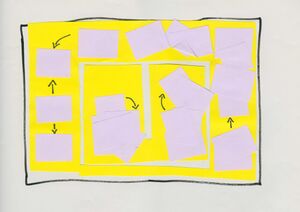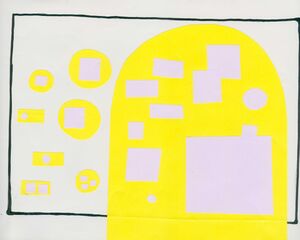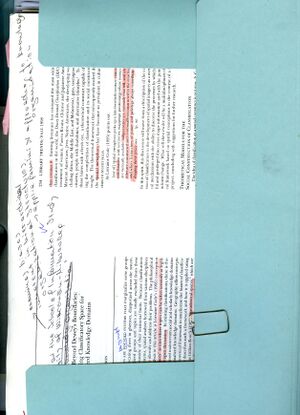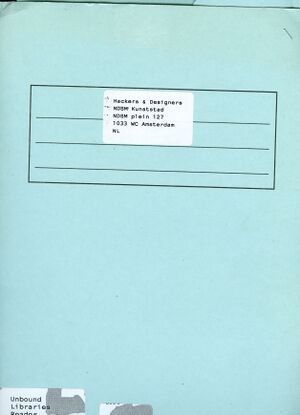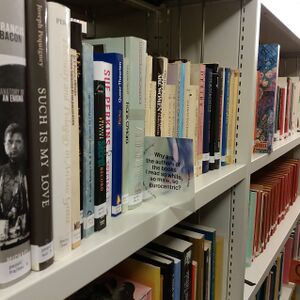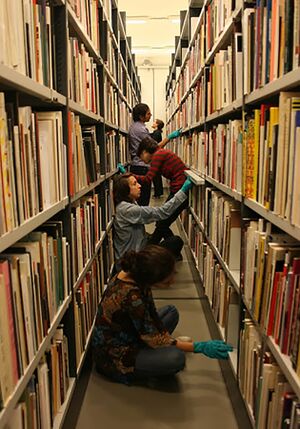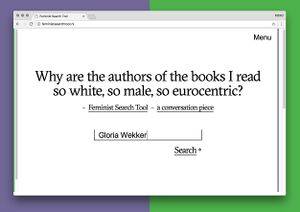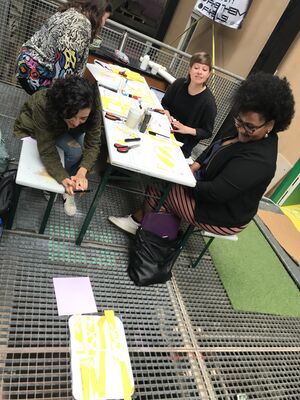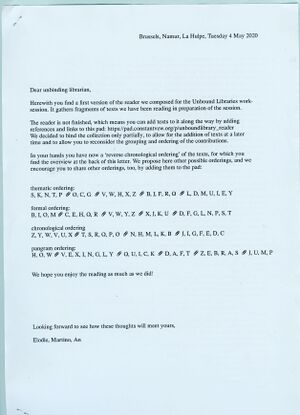
Re- and Un- Defining Tools
Exploring intersectional approaches to digital search tools in library catalogs
The Feminist Search Tools (FST) is an ongoing artistic research project that explores different ways of engaging with digital library catalogs. The FST project studies the power structures that library search engines reproduce, and views (computational) search mechanisms through an intersectional lens to inquire how marginalized voices within libraries and archives can become more easily accessible and searchable. While the initial FST study process began within the context of the Utrecht University library, the project soon shifted to focus on the catalog of IHLIA LGBTI Heritage Collection in Amsterdam.
The following texts are conversations between members of the FST project. The first conversation focuses on the different motivations that informed the FST project, and includes reflections on the different modes of working together.[1] The follow-up conversation zooms in on the “tool aspect” of the Feminist Search Tools project, its situatedness and processual nature, and the different (mis)understandings of the term “tool.”
'Tools' refers to a digital search interface in different iterations that allows for textual search queries within digital catalogs of libraries and archives. During the collaboration, the various tool versions have taken different shapes and forms, but have never really solidified in a way that made them easily applicable to contexts other than those they were developed within.[2] Instead, we have attended to the tool-making or tool-imagining process itself, which expanded our understanding of tools (digital and otherwise) and the implications they had on specific contexts.
The composition of the FST working group has changed shape throughout its duration. While Sven Engels, Anja Groten, Annette Krauss, and Laura Pardo initiated an early iteration of the FST project, others–including Angeliki Diakrousi, Alice Strete, and Ola Hassanain–joined the process at a later stage, after we had started a new iteration of the tool the so-called “visualization tool,” during the Digital Methods summer school in 2019.[3] Throughout the project, the group met sporadically and consulted with librarians, information specialists and other artists and researchers working with and around subjects related to libraries and librarianship.
The following conversation took place after the second iteration of the visualization tool was presented in a public setting and a funding cycle for this iteration was completed.
Tools as “digital study objects”
Anja Groten: Considering that we all had very different encounters and experiences with the tools created throughout the project, I propose to start our conversation with an open question: What were everyone's initial expectations towards working on a digital tool, and how have these expectations been met, or perhaps changed over time?
Annette Krauss: I still remember how some of us in the Read-in became interested in the term ‘“tool,” and more specifically a “digital tool” through the question of scale. During our previous project titled Bookshelf Research,[4] we spent time in small (grass-root) libraries studying the way the publications were categorized. For me, the Bookshelf Research was already a tool. By literally passing every single item of the library through our hands, one after the other, we got acquainted with the library and tried to understand the different categories—such as publishers, languages, gender of authors, materiality—as well as the book contents. For instance, we looked at the Grand Domestic Revolution Library of Casco Art Institute,[5] which holds around 300 books. The digital dimension of the tool became more clear when we shifted our attention to the Utrecht University library. As the library holds three million books, a contextualization counting exercise in the physical space was not possible in the same way. What has remained throughout the process is our desire to challenge the coloniality of modern knowledge production that we attempted to address with the question “Why are the authors of the books I read so white, so male, so eurocentric?”
AG: You earlier referred to the Bookshelf Research as a tool. What do you mean by that? Do you regard a “tool" as a synonym for method?
AK: I’d rather see “tool” here as a “mode of address,” or a set of search mechanisms, or maybe even principles. I think it has to do with my disbelief in the possibility of transferring methods from one context to another without causing much harm. A mode of address[6] proposes something that a method has difficulties in attending to, namely being situated and context-specific.
Sven Engels: I think for me at some point I started equating tools with "digital tools" in my head. This created a disconnect for me, because I felt I wasn't easily able to access what those tools actually do. At the same time, the notion of the tool as a "digital object"—an interface—also came with the question of the tool’s usability, which also brings up the question of "use for what" and for "whom"? For instance, the expectation that a tool should also produce some form of result was put into question. Thinking about the tool as a digital study object creates room to explore these and other questions about what the tool actually does.
AG: The idea of a tool as an enhancement, that it’s supposed to make our processes easier, might have caused some confusion around the project, don't you think? Interesting and important confusions, not to mention expectations.
Laura Pardo: When we started talking about tools rather than “the tool,” my perception and expectations toward the project changed. From the beginning, when we were talking about the FST project, for instance during our first conversation with ATRIA,[7] we had questions like: “Is the tool going to work?” There had indeed been a certain expectation for the tool to produce a result, or a solution to a problem. The fact that we decided to make a digital tool made me especially cautious. To my understanding, digital tools tend to be binary, it’s either this or that. Everything in between gets lost. Realizing that there is not just one tool but a kind of ongoing tool-making process that includes different modes and materializations through which you can ask questions about tools—was a very important part of the process.
SE: When you talk about the things getting lost do you refer to the decisions made that factor into how a tool is made or are you referring to the conversations that are part of the tool-making process that are no longer visible?
LP: It’s both. In moments like this our conversations are so valuable and important. When you have a product—a finished search interface for example—those conversational elements can get lost. I think it is great that we bring all the conversations, pieces of audio, and images together on our project website. But when making a tool you also need to come up with solutions to problems, right?
Angeliki Diakrousi: Listening to your thoughts, I want to relate back to how the question of scale played a role for you in the beginning. When a database becomes so big that we can’t relate to it anymore as a human, it exceeds our understanding and therefore challenges our capacity to trust. I also like the idea of the conversational tool because it means the tool can be scaled down and become part of the conversation, and that it doesn't have to give a solution to a problem. In conversation with the tool we can address issues that we otherwise don't know how to solve. If we can’t solve something, how would a tool solve it? The tool is our medium in a way. I am interested in finding more of these bridges to make the tool a conversational tool.
AK: I have grappled with the role of scaling throughout the process, and have been both attracted and appalled by it. This is what I tried to point to earlier with the modes of address. The work of Anna Lowenhaupt Tsing could be interesting to think about here, when she refers to scaling as a rigid abstraction process.[8] Tsing criticizes science and modern knowledge production for its obsession with scalability.
She describes scalability as the desire to change scale—for instance, by expanding a particular mode of research or production without being sensitive to the different contexts in which they are being applied. This has provoked much colonial violence because scalability avoids contextualization and situatedness in order to function smoothly, and therefore upholds an extractivist logic. I believe that through our conversations we are attempting to contextualize and situate the subject. Conversations ground us.
LP: Isn't our struggle with addressing gender, race, class, sexuality, and disability in our first prototype[9] an example in this direction? We are working with a big database and have to find solutions for certain questions, and by choosing a specific solution many other modes are not chosen, which we know can lead to misrepresentation.
Alice Strete: I remember that we were looking for the gender of the authors at the beginning of the project, and approaching it by looking at the data set of Wiki Data.[10] I think I was expecting that the information would be readily available, and that we just had to find it and figure out how to use it. But then I realized I had to adapt my expectations about how to extract insights from the database, which was not obvious to me from the beginning.
SE: The biggest clash in that regard was when we tried the Gender API.[11] It attributes a gender category on the basis of the frequency a name is used for a particular gender online. Not only does this lead to faulty results, but it’s a harmful way to use it when self-identification is so central to gender identification. This definitely forced us to rethink how gender could be identified in different ways and with tools that also take self-identification into consideration.
Ola Hassanain: When I joined the project, I asked questions that stemmed from my concern about the classifications we would be using and how the tool would filter certain searches. My concern was that the tool would transfer from one type of classification to another. When you look for “knowledge”—at least from my perspective—there is a degree of caution that you have to take. These general classifications are out there and even if you do not adhere to them or abide by them they are still there. I had a brief conversation with Annette about the tool having to be adjustable in a way that it could meet steadily changing requirements. To make a point, I used an example of the architectural catalog Neufert,[12] which has become an international standardization guideline for architectural measurements. So basically, whatever you produce as an architect or designer must comply with a set of pre-defined measurements. Anyway, my question was whether the process of tool-building is eventually perpetuating the same categories and classifications that the libraries are using. The interesting thing about the Neufert catalog is that it gets updated regularly, and it is continuously regenerating. So how can a search tool respond to something that is constantly changing?
AK: I understood the Neufert catalog more as a standardization tool, with normative rules comparable to the library classifications developed by the Library of Congress. Here however, you actually stress its flexibility.
OH: The tool has to cater to the changing times. My suspicion was about whether we can have more diverse or inclusive ways of using or sourcing references and books, and what informs such a process. If we have something like the Neufert catalog already set up in the libraries, how would the tool respond to that, and how does it regenerate?
AG: When you refer to changeability and the challenge of correcting categorization systems, I have to think of the text "Queering the Catalog: Queer Theory and the Politics of Correction by Emily Drabinski, which Eva Weinmeyr and Lucie Kolb's research project on "Teaching the Radical Catalog"[13] was inspired by. Drabinski discusses practices of knowledge organization from a queer perspective and problematizes the notion that classification can ever be finally corrected. According to Drabinski there needs to be a sustained critical awareness, and ways of teaching catalogs as complex and biased texts.[14] I remember the Unbound Library Session, organized by Constant[15] in 2020, during which Anita and Martino—who are self-taught librarians working at the Rietveld and Sandberg library[16]—presented their library search tool which allowed the users of the library catalog to suggest new categories. Thus, someone searching in the library catalog can make suggestions for modifying the system itself. The librarians would then review and apply or reject the suggestions. Their idea was to organize discussions and workshops with students and teaching staff around such suggestions. It is quite exciting to think about the changeable catalog becoming dialogic in that way.
AS: There is a big difference between using an existing search tool—into which you have less insight—and making something from scratch, so to speak, that integrates conversation at every step. I appreciate the possibility of paying attention to the decisions being made at different phases of the process.
SE: I wonder to what extent the idea to build something from scratch is even possible or desirable? I often feel that projects are trying to come up with something new and innovative, instead of acknowledging the work done by others before them, and embracing the practice of building on and complexifying what already exists. It's definitely a trap we've been conscious of ourselves, and that we’ve attempted to focus on, while making room for different perspectives and questions.
AK: I understand Alice’s comment more in terms of a search interface as black box. And indeed, we have built upon so many existing tools—like the Atria Women’s Thesaurus,[17] the Homosaurus of IHLIA,[18] and all the references mentioned by Anja. There are loads of tools, or experiments of tooling, that we have struggled with, like the first prototype, the “Feminist Search Assistant,” the paper prototypes, and the Visualization Tools (Digital Methods summer school; FST Meet-ups; IHLIA).[19]
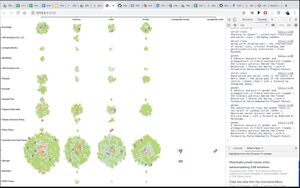
Where does the agency lie within the tool?
LP: When it comes to the user interface, we are so used to having smooth interface designs that feel just like “magic” like the experience of filling in the search window in Google, for instance[21]
It shows you the result, but we never know what is happening in the backend. I always hoped that we would do the opposite of this.
There is a lack of agency with digital tools that I don’t have with analogue tools. Like, I have a hammer; I know how it works. I am somehow much more frustrated as a user of digital tools, and I don't know how to break the distance between myself and the tool. I think we were trying to close that gap but it still felt unattainable at times.
AG: This reminds me of a subsection in a previous conversation that I wanted to elaborate on further. It’s the section “Understanding one's own tools,”[22] which is about, among other things, the implication of ownership over a tool. Even though it’s subtle, don’t our tools in a way own us too? Furthermore, when we think about tools, like software for instance,we often think about them as separate from us. There is an alleged separation between the tool builder, the tool, and the tool user. I found it so interesting how in our process—despite the friction it caused—it became clear that tools are actually not so separate from us after all. Every conversation was informed by the tool, which in turn shaped how we developed the tool. But we, as a group, were also shaped by its becoming, and we were constantly confronted by our expectations of the tool and our relationship
to it.
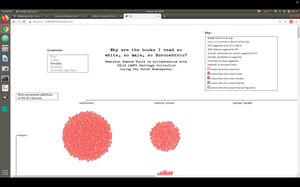
AD: I wonder how the code could also become part of this conversation. For instance, the ways we categorized the material in the code. Thinking about the code and realizing that creating intersectional[23] axes practically meant that we had to move the catalog entries from their separate categories toward the same place in the dataset. Everything had to become part of one script.
To create the different axes we connected the different terms in that script. The way we categorized the code, the file, and the scripts should also be part of that conversation. Because the code is also built on binaries and structures and is written in ways that make it difficult to complexify, it’s actually difficult to find possibilities to separate catalog items from one another. We are not professional software developers. We just happen to know a bit of coding and we are learning through this process. I am sure the tool can be much more innovative in how it is structured. It also needs a deep knowledge of the initial library tool. But yeah, it was an interesting process. I would actually like to see this conversation and our learning process reflected more visibly in the tool.
AK: Which brings us back to the “conversation tool.” All these conversations and encounters are so necessary because the digital tool itself makes them so invisible in a way.
AG: But how could they become more visible? These conversations indeed became a useful “tool” for our process as they offered us committed moments of collective reflection. On the project website,[24] the conversation became quite important as a narration of the website as well as a navigation. But what happens after the conversation? The idea of releasing the digital tool still seems to be a difficult subject for us. The way we go about the release is by making the process available and hyper-contextualizing it. There have always been specific people and specific organizations that we engaged with, and to a certain extent we also depend on these people to move forward. Don’t you think there is a danger that these conversations become too self-referential? To some extent, we do publish and release the tools through these conversations and through other forms of activation such as the meet-ups, but how do we make sure that the Feminist Search Tools contribute to or feed back into the communities they were inspired by?
SE: The conversations are perhaps more in the background of the digital tool itself. If we think, for instance, of the website and the project itself, we try to bring the conversations to the foreground. It's good to keep in mind how central these questions are to the project itself.
Exploring intersectional search[25] as a way to move beyond identity politics
AG: In the previous conversation we clarified that we understood feminism as intersectional, that different forms of discrimination cannot be seen as separate but should be always seen in relation to each other, “avoiding the tendency to separate the axes of difference that shape society, institutions, and ourselves.”[26] With the last iteration of the tool, we tried to literally intersect groups and axes of categorization, but at the same time also created new kinds of distinctions in order to make certain things legible, and others not. How are those separations, in fact feminist separations? And in what ways did the tool share our understanding of feminism?
SE: Annette and I had a conversation with Lieke Hettinga, whom we had asked for input to further explore how the x-axis terms of the visualization tool[27] related to disability, due to their expertise in disability and trans studies. Lieke questioned to what extent—when using the clusters of gender, race, sexuality, etc.—we were just reinforcing identity categories, and to what extent we were able to move beyond these categories altogether. By looking at categories individually but also trying to find connections between them, I was reminded of the underlying tension of this project, which pertained to us feeling the need to name different categories relating to identity in our question: "Why are the books I read so white, so male, so Eurocentric?,” while also desiring to move beyond them. These conversations and tensions have been an important part of the process but aren't necessarily visible in the tool as it currently exists. How can we show and make such tensions accessible to people engaging with the tool, and also have them be part of the conversation about it?
AD: I think it is important to consider the people this tool refers to in the process, involve them, but maybe not so intensively. Perhaps people don't have to understand it completely, either. It’s good that it's clear that when we say “tool” we aren’t speaking about a tool that gives solutions to problems. For me, it's important that people understand the conversational process, and that we want them to be part of it, and that they will also affect the outcome of the tool. How can a reflection on this process be opened up? How can we engage more people in this process? Maybe through workshops, or small conversations, or a broadcast?
To me this relates to feminist practice, that the tool is applied in different layers. Not only in how you make the actual tool but also in how you communicate about it, how you do things, and take care of the technical but also the social aspects.
Use value and usability
SE: I had to think of the metaphor that Ola brought up in our first conversation: the tool being a disruptive mechanism, like “throwing stones into a wheel,” which translates to how the tool exists within power structures. But at the same time I do have to admit I have a desire for the tool to actually function, which for me stems from wanting to find more queer literature. I find it very frustrating that I still cannot do so within mainstream media outlets or libraries. So, I think we should not do away with our hopes and desires for the use value of the FST. We can of course be critical about the efficiency of a tool. But at the same time, we need to understand our motivations for making it work—It’s OK that we want the tool to function and release it so that other people can engage with it as well.
OH: The desire to actually find an item in the library catalog cannot be separated from the rest of our commentary in terms of its efficiency. When a search tool is used, it creates issues while it is being used. This expectation of a useful tool and being critical of its problematics are not isolated issues. That's may be not hard to imagine, but maybe hard to articulate.
Alice: Ola, would this be an argument against the usability of such a tool?
OH: No, this is not an argument against usability but against the fact that we think it's not; that it is something separate. We shouldn’t look at its usability as something that is sort of neutral and separate, that is part of the problem. It creates and perpetuates the same issue because the tool is already something that gives analytics to the bigger body of the library. Through that patterns are formed, and the interface responds to it. So, we are caught in an enclosure of this desire that is already informed by how the knowledge is institutionalized or how that knowledge is classified. I think there has to be an awareness of that.
AD: The way that I envision it, is that it's not going to be a “beautiful” interface that is easy-going. It will show the fragments of learning that went into it.
AG: Yes, the tool also demands a certain level of care and commitment. Perhaps it should not be thought of as something that can be finished, that stands on its own, rather as something that is never resolved and needs continuous engagement, like a practice.
AK: For me it links back to a certain attitude towards tools. I don't believe that a complete understanding of a library search tool and its implications is possible. But perhaps it is possible to strive for a certain kind of literacy that supports both a questioning attitude towards tool-use, and is informed by a quest for social justice. Perhaps this way the complicities of a tool-users in the modern project of education that libraries are also embedded in can be addressed?
Members of the Feminist Search Tools working group include: Read-in (Sven Engels, Annette Krauss, Laura Pardo; and Ying Que who was involved in certain parts of the project), Hackers & Designers (Anja Groten, André Fincato, Heerko van der Kooij, and former member James Bryan Graves), Ola Hassanain, Angeliki Diakrousi, and Alice Strete.[28]
